Minnesota Historical Society
The Minnesota Historical Society (MNHS) is a nonprofit educational and cultural institution dedicated to preserving the history of the U.S. state of Minnesota. It was founded by the territorial legislature in 1849, almost a decade before statehood. The Society is named in the Minnesota Constitution. It is headquartered in the Minnesota History Center in downtown Saint Paul.
 'M' of the Minnesota Historical Society's Logo | |
| Formation | 1849 |
|---|---|
| Headquarters | Saint Paul, Minnesota |
| Website | www |
Although its focus is on Minnesota history it is not constrained by it. Its work on the North American fur trade has been recognized in Canada as well.[1]
MNHS holds a collection of nearly 550,000 books, 37,000 maps, 250,000 photographs, 225,000 historical artifacts,[2] 950,000 archaeological items,[3] 38,000 cubic feet (1,100 m3) of manuscripts,[4] 45,000 cubic feet (1,300 m3) of government records, 5,500 paintings, prints and drawings; and 1,300 moving image items.
MNopedia: The Minnesota Encyclopedia, is since 2011 an online "resource for reliable information about significant people, places, events, and things in Minnesota history", that is funded through a Legacy Amendment Arts and Cultural Heritage Fund grant and administered by the Minnesota Historical Society.[5] The Minnesota Historical Society Press (MNHS Press) publishes books on the history and culture of Minnesota and the Upper Midwest with the goal of advancing research, supporting education, and sharing diverse perspectives on Minnesota history.[6] MNHS Press is the oldest publishing company in the state of Minnesota and the largest historical society press in the nation, with more than 500 books in print. MNHS Press also produces the quarterly magazine, Minnesota History (journal).
State historic sites
The Minnesota Historical Society operates 31 historic sites and museums, 26 of which are open to the public. MNHS manages 14 sites directly and 10 in partnerships where the society maintains the resources and provides funding. Five sites are being held for preservation but are closed to public access, and two are self-guided sites with interpretive signage.[3] Seven of the sites are National Historic Landmarks and 16 others are on the National Register of Historic Places (NRHP). Seven sites lie within Minnesota state parks, and three are elements of the Mississippi National River and Recreation Area.[7]
| Site name | Image | Location | Era of features | Year added to MNHS | Management[3] | Remarks |
|---|---|---|---|---|---|---|
| Alexander Ramsey House |  | St. Paul | 1872–1964 | 1964 | Direct | Home of Minnesota governor and U.S. Congressman Alexander Ramsey with original furnishings.[8] NRHP |
| Birch Coulee Battlefield | Morton | September 2, 1862 | Self-guided | Site of the Battle of Birch Coulee, the deadliest battle for U.S. troops in the Dakota War of 1862.[9] NRHP. | ||
| Charles Lindbergh House and Museum |  | Charles A. Lindbergh State Park | 1906–1920 | Direct | House of U.S. Congressman Charles August Lindbergh and his son, aviator Charles Lindbergh.[10] National Historic Landmark[11] | |
| Comstock House | 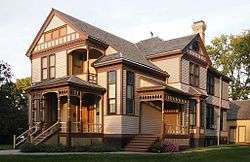 | Moorhead | 1882 | Partnership | Restored home of U.S. Congressman and businessman Solomon Comstock with its original furnishings.[12] NRHP | |
| Folsom House |  | Taylors Falls | 1854–1968 | 1968 | Partnership | Restored home of businessman, politician, and historian W.H.C. Folsom with its original furnishings.[13] NRHP contributing property |
| Forest History Center | 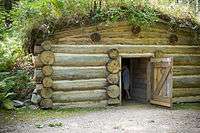 | Grand Rapids | 1900–1934 | Direct | Recreated logging camp and exhibits on humankind's relationship with Minnesota's forests.[14] | |
| Fort Renville | Lac qui Parle State Park | 1822–1846 | 1973[15] | Preservation | Location of a fur trading post established by Joseph Renville.[16] | |
| Fort Ridgely |  | Fort Ridgely State Park | 1853–1867 | Partnership | Fort built to keep the peace around a Dakota reservation, but attacked twice during the Dakota War of 1862.[17] NRHP | |
| Grand Mound |  | International Falls | 200 BCE–1400 | 1971 | Preservation | Five burial mounds include the largest prehistoric structure remaining in the Upper Midwest, 25 feet (7.6 m) high and 100 feet (30 m) in diameter.[18] National Historic Landmark[19] |
| Harkin Store | 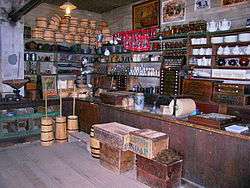 | New Ulm | 1870–1901 | 1973 | Partnership | General store first built in the 1870s with much of the original inventory still on display.[20] NRHP |
| Historic Forestville |  | Forestville Mystery Cave State Park | 1853–1899 | 1978 | Direct | The remains of the once-bustling 19th century town of Forestville, which became a ghost town after the railroad passed it by.[21] NRHP |
| Historic Fort Snelling |  | Fort Snelling State Park | 1820–1946 | Direct | Portions of the fort have been restored to their original frontier appearance, while later additions served as barracks for soldiers training during World War II.[22] A National Historic Landmark[23] and part of the Mississippi National River and Recreation Area.[7] | |
| James J. Hill House |  | St. Paul | 1891–1921 | 1978 | Direct | Mansion of railroad magnate James J. Hill.[24] National Historic Landmark[25] |
| Jeffers Petroglyphs |  | Jeffers | 3000 BCE–1750 | 1966 | Direct | Exposed rocks bear ancient Native American petroglyphs.[26] NRHP |
| Lac qui Parle Mission | Montevideo | 1835–1854 | 1973[15] | Partnership | Reconstructed wooden church where missionaries worked to convert the Dakota.[27] NRHP | |
| Lower Sioux Agency |  | Lower Sioux Indian Reservation | 1853– | Partnership | Museum depicting the lives of Dakota people before and after the Dakota War of 1862.[28] NRHP | |
| Marine Mill | 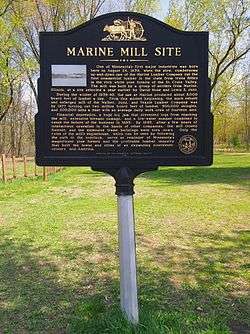 | Marine on St. Croix | 1839–1895 | Partnership | Ruins of Minnesota's first commercial sawmill.[29] NRHP | |
| Mill City Museum | 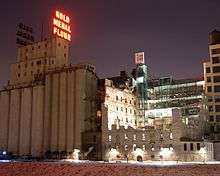 | Minneapolis | 1874–1965 | Direct | Museum of the flour milling industry that built Minneapolis, within the ruins of the Washburn "A" Mill,[30] a National Historic Landmark.[31] Part of the Mississippi National River and Recreation Area.[7] | |
| Mille Lacs Indian Museum | 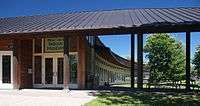 | Mille Lacs Indian Reservation | Prehistory–present | Direct | Museum of the history and culture of the Mille Lacs Band of Ojibwe.[32] | |
| Minnehaha Depot | 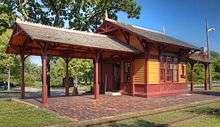 | Minneapolis | 1875–1963 | 1964 | Partnership | Former train station near Minnehaha Falls with "gingerbread" Victorian architecture. Operated by the Minnesota Transportation Museum.[33] |
| Minnesota History Center |  | St. Paul | Prehistory–present | Direct | Minnesota Historical Society's headquarters, with permanent exhibits about Minnesota, changing exhibits about national history, and a library.[34] | |
| Minnesota State Capitol |  | St. Paul | 1905–present | 1969 | Direct | Tours and exhibits of the state's seat of government.[35] NRHP |
| Morrison Mounds | Battle Lake | 690 BCE[36] | 1968[18] | Preservation | Includes the oldest burial mound in Minnesota.[37] NRHP | |
| Oliver Kelley Farm | 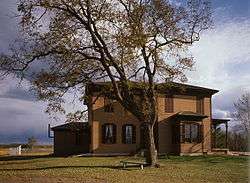 | Elk River | 1850–1901 | 1961 | Direct | Frontier farmstead of Oliver Hudson Kelley, one of the founders of the National Grange of the Order of Patrons of Husbandry.[38] National Historic Landmark[39] |
| Sibley Historic Site |  | Mendota | 1838–1910 | Partnership | Homes of Henry Hastings Sibley, Minnesota's first state governor, and fur trader Jean-Baptiste Faribault.[40] NRHP and part of the Mississippi National River and Recreation Area.[7] | |
| Snake River Fur Post | 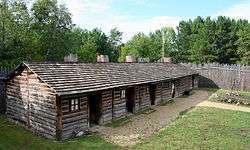 | Pine City | 1804 | Direct | Recreated North West Company trading post and Ojibwe encampment.[41] NRHP | |
| Split Rock Lighthouse |  | Split Rock Lighthouse State Park | 1910–1969 | 1976 | Direct | Clifftop lighthouse on Lake Superior restored to its 1920s appearance.[42] National Historic Landmark[19] |
| Stumne Mounds | Pine City | 1968[18] | Preservation | Group of linear burial mounds near the Snake River.[36] NRHP | ||
| Traverse des Sioux |  | St. Peter | Prehistory–1869 | 1981 | Self-guiding | Site of a river ford, the signing of the Treaty of Traverse des Sioux, and a former town.[43] NRHP |
| Upper Sioux Agency |  | Upper Sioux Agency State Park | 1854–1862 | 1969[44] | Preservation | Location of a federal agency established to convert Dakotas to a Euro-American farming lifestyle, but destroyed in the Dakota War of 1862.[16] NRHP |
| W.W. Mayo House | 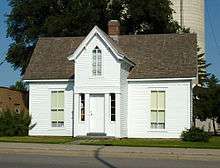 | Le Sueur | 1859– | Partnership | Home built by William Worrall Mayo, founder of the Mayo Clinic, and later home of Carson Nesbit Cosgrove, founder of the Green Giant food company.[45] NRHP |
Document depositories
- "Journals (Minnesota history v1-4; Collections, Biennial reports, Annals etc) and other documents of the Minnesota Historical Society". Minnesota Historical Society / Internet Archive. Retrieved November 24, 2012.
These publications are described in more detail in an online format (without the downloadable document formats available above), at the MHC's own Digital History Books page (Retrieved November 24, 2012)
References
- "The story of the Canadian fur trade owes a great debt . . . for research and general popularization, to the Minnesota Historical Society."Morse, Eric (1979). Fur Trade Routes of Canada. Minoqua, WI: NorthWord Press. p. 74. ISBN 1-55971-045-4.
- "Artifact Collection". Minnesota Historical Society. Retrieved 2011-07-21.
- "Historic sites and museums". Minnesota Historical Society. Retrieved 2011-07-21.
- "Manuscripts Collection". Minnesota Historical Society. Retrieved 2011-07-21.
- "MNopedia: Minnesota Encyclopedia". Minnesota Historical Society. Retrieved January 2, 2018.
- "Minnesota Historical Society Press". MNHS Press.
- National Park Service (2011-02-16). "Mississippi National River and Recreation Area: Plan Your Visit". U.S. Department of the Interior. Retrieved 2011-03-25.
- "Alexander Ramsey". Minnesota Historical Society. Retrieved 2007-08-16.
- "Birch Coulee Battlefield". Minnesota Historical Society. Retrieved 2007-08-16.
- "Charles A. Lindbergh House". Minnesota Historical Society. Archived from the original on 2008-04-11. Retrieved 2007-08-16.
- "Lindbergh, Charles A., Sr., House". National Park Service. Archived from the original on 2011-06-06. Retrieved 2011-07-21.
- "Comstock House". Minnesota Historical Society. Retrieved 2007-08-16.
- "Folsom House". Minnesota Historical Society. Retrieved 2007-08-16.
- "Forest History Center". Minnesota Historical Society. Retrieved 2007-08-16.
- Meyer, Roy W. (1991). Everyone's Country Estate: A History of Minnesota's State Parks. St. Paul, Minn.: Minnesota Historical Society Press. ISBN 0-87351-266-9.
- "Minnesota River Valley Scenic Byway: Discovery Sites". Minnesota River Valley Scenic Byway Alliance. Retrieved 2011-07-21.
- "Fort Ridgely". Minnesota Historical Society. Retrieved 2007-08-16.
- "Report to the Minnesota Legislature on the Future of the Grand Mound State Historic Site, Koochiching County" (PDF). Minnesota Historical Society. 2007-01-31. Retrieved 2011-07-21. Cite journal requires
|journal=(help) - "Listing of National Historic Landmarks by State: Minnesota" (PDF). National Historic Landmarks Survey. National Park Service. Retrieved 2011-07-21.
- "Harkin Store". Minnesota Historical Society. Retrieved 2007-08-16.
- "Historic Forestville". Minnesota Historical Society. Retrieved 2007-08-16.
- "Historic Fort Snelling". Minnesota Historical Society. Retrieved 2007-08-16.
- "Fort Snelling". National Park Service. Archived from the original on 2008-03-13. Retrieved 2011-07-21.
- "James J. Hill House". Minnesota Historical Society. Retrieved 2007-08-16.
- "Hill, James J., House". National Park Service. Archived from the original on 2011-06-06. Retrieved 2011-07-21.
- "Jeffers Petroglyphs". Minnesota Historical Society. Retrieved 2007-08-16.
- "Lac qui Parle Mission". Minnesota Historical Society. Retrieved 2007-08-16.
- "Lower Sioux Agency". Minnesota Historical Society. Retrieved 2007-08-16.
- "Marine Mill". Minnesota Historical Society. Retrieved 2007-08-16.
- "Mill City Museum". Minnesota Historical Society. Retrieved 2007-08-16.
- "Washburn A Mill Complex". National Park Service. Archived from the original on 2011-06-06. Retrieved 2011-07-21.
- "Mille Lacs Indian Museum". Minnesota Historical Society. Retrieved 2007-08-16.
- "Minnehaha Depot". Minnesota Historical Society. Retrieved 2007-08-16.
- "Minnesota History Center". Minnesota Historical Society. Retrieved 2007-08-16.
- "Minnesota State Capitol". Minnesota Historical Society. Retrieved 2007-08-16.
- Johnson, Elden (1988). Prehistoric Peoples of Minnesota. Minnesota Historical Society Press. ISBN 978-0-87351-223-7.
- "TimePieces: Mounds". Minnesota Historical Society. Archived from the original on 2004-11-09. Retrieved 2011-07-21.
- "Oliver H. Kelley Farm". Minnesota Historical Society. Retrieved 2007-08-16.
- "Kelley, Oliver H., Homestead". National Park Service. Archived from the original on 2011-06-06. Retrieved 2011-07-21.
- "Sibley House Historic Site". Minnesota Historical Society. Retrieved 2007-08-16.
- "North West Company Post". Minnesota Historical Society. Retrieved 2007-08-16.
- "Split Rock Lighthouse". Minnesota Historical Society. Retrieved 2007-08-16.
- "Traverse des Sioux". Minnesota Historical Society. Retrieved 2007-08-16.
- "Upper Sioux Agency State Park" (PDF). Minnesota Department of Natural Resources. June 2011. Archived from the original (PDF) on 2012-03-26. Retrieved 2011-07-21. Cite journal requires
|journal=(help) - "W.W. Mayo House". Minnesota Historical Society. Retrieved 2007-08-16.
External links
| Wikimedia Commons has media related to Minnesota Historical Society. |
- Minnesota Historical Society
- Placeography – wiki operated by the Minnesota Historical Society